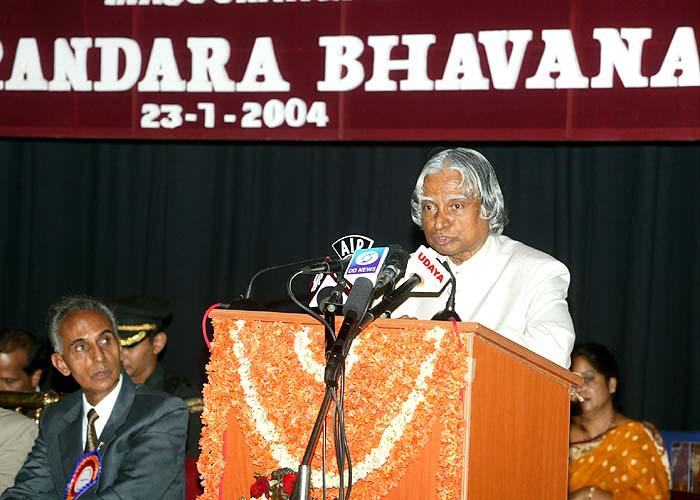Address At The Inauguration Of Purandara Bhavana Of Indiranagar Sangeetha Sabha, Bangalore
Bangalore : 23-04-2004
I am delighted to participate in the inauguration of Purandara Bhavana of Indiranagar Sangeetha Sabha. My greetings to the pioneers who conceived and established this Sangeetha Sabha, artistes, music lovers and distinguished guests participating in this function.
Music, particularly carnatic music elevates human soul. I am reminded of the Rumi?s poem which reads as follows:
"Angel is free because of his knowledge,
The beast because of his ignorance,
Between the two remains the son of man to struggle?
How to come out of this human struggle"
How to elevate the children of God to angelic state? This can be done only by music.
I indeed had the great fortune of a good friend, who taught me carnatic music. Every time I hear Purandara Dasa composition ?Bhagyada Lakshmi baramma?? in Madhyamavati raga, particularly when this kirtana is sung by M.S. Subbulakshmi, it is indeed heavenly. Such a great elevating musical treat. I like it.
Friends, some time ago a Professor visiting from a American University met me at Rashtrapati Bhavan. The Professor asked me: ?Mr. President what is the core competence of India?? I said, India has a population of a billion people with multiple cultures, multiple languages and multiple religions. After our independence in 1947, we have been handling the challenge of caring and catering for masses from poverty and provide proven leadership to these people in a democratic way. Managing a billion people with their problems in a democracy is a unique effort.
How do we connect these billion people? It is a big task. Our civilizational heritage has given us certain unique binding and integration. Music, particularly, classical Hindustani music in the North and carnatic music in south have proved to be great integrators of people.
You will find, in Hindustani music, whether it is Sitar or Vocal or Shenai it always attracts a wide spectrum of people from all walks of life. I am personally experiencing it. At Rashtrapati Bhavan, we have bimonthly musical programmes called ?Indradhanush?. I am sure carnatic music also has larger audiences across various sections of the society.
Some say, 15th century AD was the golden period of South Indian Music. Because, during this period, Annamacharya in Telugu and Arunagirinathar in Tamil and Purandaradasa in Kannada were contributing immensely to the cause of carnatic music in these languages. I have also heard about interesting interactions between Annamacharya and Purandara Dasa.
Purandara Dasa?s life is indeed very rich in resource and intellect. It was a beautiful life. The way he gave up his material attachments and a life of wealth and opulence is revealing. He started composing poems in 1514 after his enlightenment. His famous first kirtana after enlightenment Mosa Hodha nallo was a landmark.
From there, he went on to compose more than 4,75,000 kirtanas, all full of captivating devotional mood and liberating experience. However, only about 8000 of them are available to us today. His mesmerizing compositions attracted millions of devotees and made them call him reverentially and affectionately Adi Guru and Pitamah.
I am happy to dedicate the Purandara Bhavana to the nation. I suggest, the Purandara Bhavana can have the following three missions:
1. Propagating beautiful musical kirtanas of Purandaradasa, among young and old.
2. Carrying out research to discover the more than 460,000 missing compositions of Purandara Dasa and retrieve them for humanity.
3. Scholars should discover and elucidate the hidden treasures bequeathed by Purandara Dasa in his work, like in Maya Malava Goula. Experts use Purandara Dasa?s Maya Malava Goula Raaga to explain the 72 melakartas. I am sure, there are several other treasures hidden in Purandara Dasa?s work like this.
May God bless you all.

